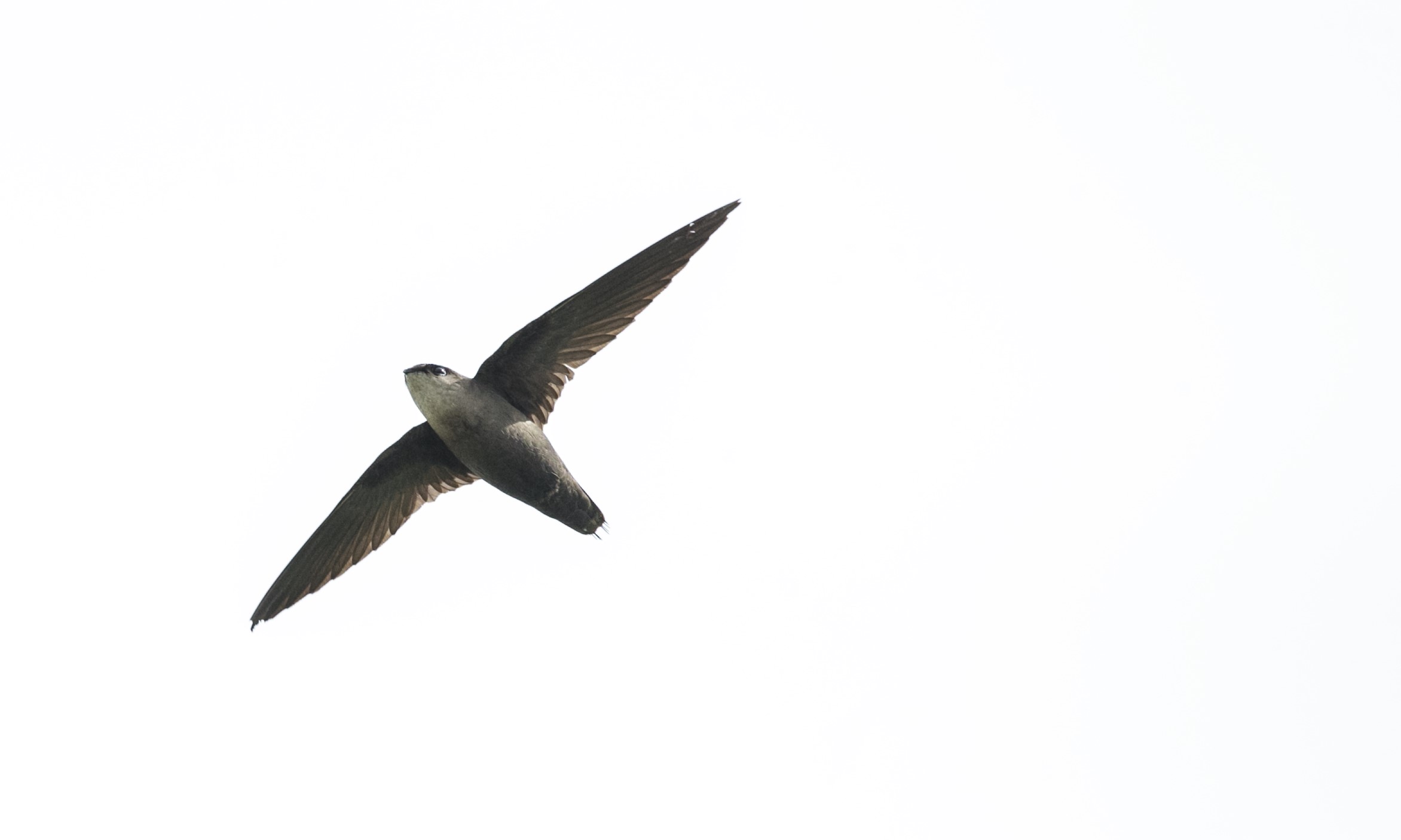The goal of the Chimney Swift Restoration Fund (the Chimney Swift Fund) is to help maintain nesting and roosting sites for the Chimney Swift by providing financial support for the restoration of anthropogenic structures (i.e., chimneys, barns, etc.) known to be important for the species in Canada. The Chimney Swift Fund helps address the threat of continued habitat loss to Chimney Swifts and aids recovery efforts for this species at risk.
The Chimney Swift, a Species at Risk
The Chimney Swift is a small dark grey-brown bird superficially resembling a swallow in its appearance and behaviour. It is sometimes referred to as the “flying cigar,” as it is characterized by a cigar-shaped body, long, narrow, tapered wings, and a short tail. The Chimney Swift is both an aerial insectivore and a long-distance migrant, two groups of North American birds in rapid decline. It breeds in eastern North America and migrates through the Caribbean and Central American to spend the rest of the year in northwestern South America.
Its breeding range in Canada is situated in the south-central and southeastern parts of the country, extending from eastern Saskatchewan to Nova Scotia. Most Chimney Swifts arrive in Canada between late April and mid-May, depending on the latitude of a given site. Most have left for their southbound migration by mid-October.
In the past, Chimney Swifts mainly nested and roosted in large-diameter hollow trees in old-growth forests. However, over the past 400 years, the availability of suitable trees within the North American landscape has declined drastically. As a result, the species has become largely dependent on anthropogenic structures, primarily chimneys, for nesting and roosting.
While a chimney used for nesting is occupied by only one pair, several dozen to more than 1,000 individuals may roost in a single chimney at night or in cold or rainy weather during the day. Roosts are mostly used by migrating birds but can be used by non-breeding individuals throughout the nesting season.
The Canadian population of Chimney Swifts has declined by nearly 90% since 1970, likely due to reduced insect prey availability and the loss of nesting and roosting sites. The Chimney Swift has been listed as Threatened under the federal Species at Risk Act since 2009. It is also protected under specific laws and regulations in every province where it breeds except Saskatchewan. The breeding population size in Canada is currently estimated to be around 45,000 individuals.
As Chimney Swifts show high fidelity to their nesting and roosting sites, a threat to their survival is the loss of suitable chimneys. Capping, lining, and screening of chimneys render the chimneys unusable to Chimney Swifts, and the demolition of degraded chimneys removes the habitat entirely for this species. The Chimney Swift Fund will help partners and chimney owners undertake work to repair damaged chimneys and thus maintain the structures as usable Chimney Swift habitat. These restoration projects will help reduce the impact of habitat loss on this species at risk.
Eligibility requirements
Who can apply
- Any owner of a chimney or other structure in need of repair that is known to be used by Chimney Swifts for nesting or roosting in Canada.
- A third party, such as a conservation group, may lead a restoration project for an owner, for which they will work to provide the necessary matching funds (at least 50% of the total amount) from non-federal sources.
Chimney owners in Manitoba should contact the Manitoba Chimney Swift Initiative before applying here, as they have a specific chimney restoration program for the province.
Eligible restoration projects
Any repair work to an anthropogenic structure, such as a chimney, used by nesting or roosting Chimney Swifts may be eligible for financial support based on the site’s location, the ability to match funds, and the ability to maintain the suitability of the structure for Chimney Swifts.
Location: the site must be in Canada (for projects in Manitoba, see Who can apply).
Matching funds: support from the Fund can cover a maximum of 50% of the total project cost. The applicant will be required to match funds on a 1:1 basis.
Maintaining the site for Chimney Swifts: repair work on the structure must be done in such a way as not to alter the characteristics that make it suitable for the Chimney Swift. The repair of a structure should meet the following criteria:
- It will maintain a sufficiently large opening to allow swifts to enter. A diameter (round structure) or diagonal (rectangular or square structure) of at least 28.5 cm is usually adequate for the species.
- If the repair work involves reducing the height of the structure, it will maintain a final height (the distance from the rooftop where the chimney emerges to the top of the chimney) of at least 2 m.
- The chimney interior will retain a rough or porous surface (made of brick, stone or concrete). The project must not involve the installation of a metal liner.
- The restoration will not obstruct the chimney opening with a screen, cap or spark arrestor.
Projects involving the uncapping of chimneys previously used by Chimney Swifts may also be eligible, depending on how recently the chimney was capped.
Projects will be vetted to ensure that they will support the long-term conservation of Chimney Swifts (see Evaluation process below). This year, appropriate projects will be supported on a first-come, first-served basis. Applicants are encouraged to apply as soon as possible to maximize the likelihood of receiving support.
Eligible costs
All costs associated with the repair are eligible for 1:1 matched support, including but are not limited to chimney assessment, materials, and labour costs.
Time frame for repair work
Work eligible for the Fund cannot have begun before April 1, 2024 and must be completed by March 31, 2025. In addition, the repairs must be completed (or have been completed) during the Chimney Swifts’ absence. This species usually leaves between early September and mid-October and returns around mid-April, but the specific dates depend on the region. For more information, please consult the Application Guidelines.
If the project involves the removal of a chimney cap for an inactive chimney, the appropriate dates for the work will be on a case-by-case basis. To discuss such a project, please contact us at chimneyswiftfund AT birdscanada.org.
Submitting a funding proposal
Before submitting a funding proposal, please read through the Application Guidelines document carefully. Then, follow the instructions in the document to fill out and submit the Application Form. If you require assistance with the application process, please contact the Fund Coordinator, Gwendolyn Clark, at gclark AT birdscanada.org.
Permitting requirements
The Chimney Swift is listed as “Threatened” under the federal Species at Risk Act. This law requires a permit to carry out certain repairs on a structure used by the species. However, a permit is not necessary for projects that leave the interior of the structure intact and accessible to Chimney Swifts and that are conducted while the birds are absent. Nevertheless, applicants should consult the federal permitting guidelines to ensure that their project complies with all regulations.
Under the above conditions of the Fund, a provincial permit is also not required to conduct a restoration project in Saskatchewan, Québec or New Brunswick.
In Nova Scotia, a permit is required by the province even when the project is conducted outside of the period when Chimney Swifts are present. Please contact the Biodiversity Program of the Department of Natural Resources and Renewables (Biodiversity AT novascotia.ca) to get the necessary application form.
In Ontario, information about the restoration project must be submitted to the Ministry of the Environment, Conservation and Parks (SAROntario AT ontario.ca) to determine whether a permit would be required or not.
Evaluation process
Applications will be vetted by the Chimney Swift Fund Committee, which includes members from different regions across the Canadian geographic range of the species. The Committee will review proposals to ensure the restoration work will not reduce the structure’s suitability for Chimney Swifts. This year, applications approved by the Committee will be funded on a first-come, first-served basis.
Terms of the Fund
Successful applicants must sign an Agreement with Birds Canada before they can receive the first payment. This document includes a commitment by the applicant to carry out the repair work and preserve the characteristics that make the structure suitable for the use of the Chimney Swift.
Successful applicants must agree to keep the structure accessible to Chimney Swifts through a long-term protection plan (10 years). Successful applicants must also commit to monitoring the structure for Chimney Swift activity (2-4 short surveys per year) in the five years following the restoration work. Applicants may monitor the site themselves or authorize provincial Chimney Swift monitoring program volunteers to do so.
Half of the awarded amount will be sent at the start of the repair work and the other half on its completion.
Key Resources
More information about the Chimney Swift:
Key information for municipalities and chimney service providers – Birds Canada
Revealing the life of our upstairs neighbours: Chimney Swifts (video) – Birds Canada
Reports from the Government of Canada:
Recovery Strategy for the Chimney Swift (Chaetura pelagica) in Canada
Chimney Swift species account in the Species at Risk Public Registry
COSEWIC assessment and status report on the Chimney Swift (Chaetura pelagica) in Canada
Citizen science monitoring programs:
Saskatchewan Chimney Swift Initiative
Contact information
For more information, application assistance, or to discuss a potential restoration project, please contact us at chimneyswiftfund AT birdscanada.org.
If you would like to report a site used by Chimney Swifts, please contact your regional Chimney Swift monitoring program (links above).
Partners
The Chimney Swift Chimney Restoration Fund is a project undertaken by Birds Canada with the financial support of the Government of Canada through the Department of Environment and Climate Change and with support and guidance from diverse partners from Saskatchewan to Nova Scotia.


